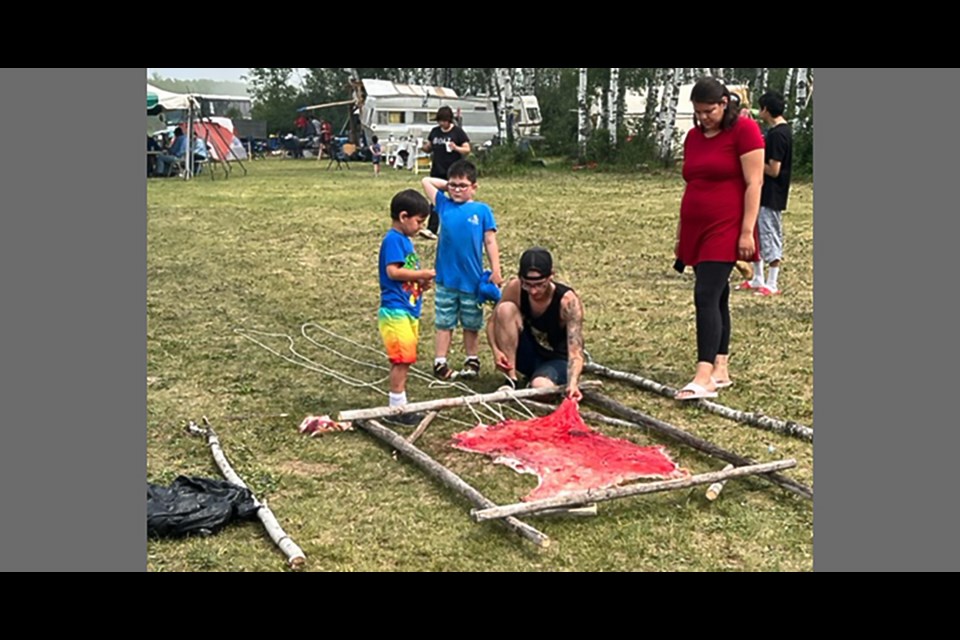KAPAKWAWANO SKĀN (PEEPAW PLAINS) — A First Nation Language and Traditional Culture Camp was held at Peepaw Plains, about 30 miles north of Norquay, July 17 to 23.
The culture camp came about as a consequence of the Truth and Reconciliation agreement between First Nations and the Federal Government, which included a call for action, and it was the result of about a year’s worth of meetings, said Elder Madeleine Whitehawk last week, as she discussed the camp and other elements of First Nation culture during a meeting in her home at Cote First Nation.
Whitehawk was among the Elders who organized and led the camp. Also participating were “Elderly knowledge keepers”: Josephine Cote, Vernon Cote, Jean Shingoose and Wanda Cote. Together they were incorporated as a non-profit organization known as Kici-anisinā pek. Representing the Yorkton Tribal Council (YTC) was Gaurav Thakur, the owner of Dixie Cups in Kamsack, and who works with the YTC as an economic development officer.
Although Peepaw Plains is the name on the map, the area is known by its traditional name: Kapakwawano skān, which means “overwhelmed with vegetation,” Whitehawk explained, adding that rather than Saulteaux, First Nations people in the area should more correctly be known as Onakawé.
Saulteaux, the French word that has been used in the past for the area’s First Nation population, is not flattering, Whitehawk said.
The Kapakwawano skān area is sacred grounds for Onakawé, she said. It is the forested area where the Littlewolf people lived, not having believed in the treaties. In time though, the Indian agents sought them out.
“We’re seventh generation Littlewolfs,” she said. “My great-grandmother Margaret Littlewolf used to refer to the Peepaw Plains as “life begins here.”
It was decided to hold the culture camp in order to have youngsters and Elders get together and the Elders teach the basic traditional skills.
Among skills taught at the camp were: cutting and drying of meat; tanning hides; drum making; teaching men’s and women’s protocol; traditional cooking; baking bannock outside; sweetgrass picking and hunting for medicines.
Each day was a fun day, she said. Among the fun activities organized were foot races, a tug-o-war, three-legged races, and tea and bannock-making competitions.
It was fun watching the kids gathering the wood to make the fire, brewing the tea and making the bannock, said Wanda Cote, a retired social worker.
During the conversation, Whitehawk displayed several First Nation traditional items, including two dried moose noses that were used to make soup at the camp; ribbon skirts with elaborate embroidery and traditional designs; a cradle board for babies and two rabbit skulls that were used in a traditional game.
Her brother, Andrew Quewezance of Keeseekoose First Nation, brought out original handmade tools that he used at the camp to demonstrate how flesh is scraped from the underside of a hide and fur is scraped off the outside.
Among the crafts that were instructed were: the making of cradle boards and moss bags.
Attending were about 45 youngsters from babies to late teens, who spent the nights in tents while guests made use of three teepees that had been set up at the location, Whitehawk explained. In addition to Cote First Nation, the youngsters came from Long Plain First Nation in Manitoba and from Fishing Lake, Ochapowace and Little Pine First Nations in Saskatchewan.
A goal is to develop a language curriculum to be used in the schools, she said. “We need more emphasis on developing our language, which is not being done as well as it could.”
“There are things in language that you can’t learn in a classroom and you have to be on the land,” Cote said, mentioning as examples, the picking of basic medicines and hunting skills.
“We need to develop the language locally,” said Whitehawk, who has a university degree in education and a linguist background. “Although many Elders speak, read and write Onakawé, and know about its grammatical structure, we are losing the Elders, so it’s important to pass on this information as soon as possible.”
“One way of life for Native people is sharing,” Quewezance explained. “If we didn’t share, we wouldn’t have survived. Now it’s up to us to pass that on to our grandchildren.
“We need a strong cultural foundation to develop our way of life and it must be connected to land-based activity.”
“People say that we’re losing our language, but that’s not correct,” Whitehawk said. “The language is losing us. It’s there and it’s pure, it just needs to be developed.”
Learning about First Nation culture and traditions will help with social problems including addictions and suicides, which are affecting younger and younger people, Cote said. Learning the culture will provide a strong foundation to survive in both worlds [First Nation and non-First Nation].
“If we learn the roots, healing will take place,” Whitehawk said. “We need to go back to our roots. It’s fortunate that we haven’t lost them completely, but we have to practice.”
“It’s who we are,” Quewezance added. “It’s the way of life given to us Native people, but because of the interference of the Europeans, we lost it.
“If we go back to land-based healing, without drugs, just time, we will get results. I believe that.”
During the conversation, Cote said she had been angered recently hearing the news that the Canadian government had discharged the Catholic Church $25 million it had agreed to pay First Nations as reparations for the debacle of the residential schools.
It is hoped that the cultural camp will be an annual event, held each July, Whitehawk said. Among funders of the camp was Kia Canada.




